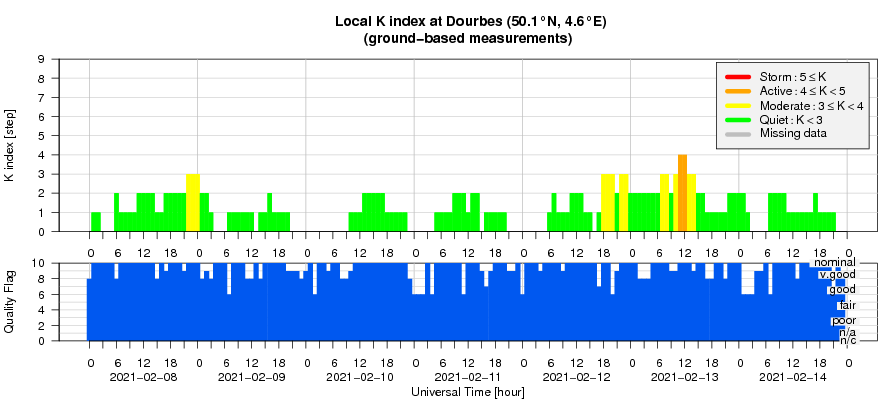- Table of Content
- 1.10 Feb 2021 - ...
- 2.Delivery servi...
- 3.Review of sola...
- 4.The Internatio...
- 5.PROBA2 Observa...
- 6.Review of geom...
- 7.Geomagnetic Ob...
- 8.The SIDC Space...
- 9.Review of iono...
2. Delivery service of SWx experts
3. Review of solar activity
4. The International Sunspot Number by Silso
5. PROBA2 Observations (8 Feb 2021 - 14 Feb 2021)
6. Review of geomagnetic activity
7. Geomagnetic Observations at Dourbes (8 Feb 2021 - 14 Feb 2021)
8. The SIDC Space Weather Briefing
9. Review of ionospheric activity (8 Feb 2021 - 14 Feb 2021)
10 Feb 2021 - EUI is 1 year in space
The extreme ultraviolet imager, EUI is 1 full year in space in its VIP seat behind the heath shield from where it peeks through a hole at the Sun. The EUI team worked hard to get down the coolest images ever.
One milestone - before launch
The challenge to get the best, started already when EUI was still on Earth. There were some 'issues' with the high resolution telescope HRIEUV which sharpness was not as expected. In such situations, when time is ticking and you have to stay on schedule, one has to think fast, one has to be pragmatic, cleaver and inventive. Frédéric combined these skills which resulted in a magic trick with a bucket of Scotchweld 3M 2216 glue. No idea what he exactly did, but the result was an instrument with a very sharp look.
Another milestone - after launch
Once the instrument is in space, the testing in real space conditions starts. Emil threw himself on this task: 'This basically means that you tell the instrument to take images using certain settings and filters, such that we learn how to take the best possible images. When the science phase of the mission starts, we should know all about EU up to the smallest detail.'
Still more - down to Earth
Taking pictures is 1 thing. Getting pictures down to Earth is another thing. David explains: 'The communication with the distant Solar Orbiter satellite is limited and difficult. We have a complex computer onboard that manages for us which images to take at what time. Like every computer, also the EUI computer needs input and delivering that input in time litteraly across the planetary system is taken up LOTS of our time.'
But time to work on this problem is the least. If you are with more, the time to work on it increases. But this rule doesn't apply on the telemetry available to send data down.
The EUI team has to share the Solar Orbiter band width with other instrument teams. EUI is not alone on Solar Orbiter. The EUI team had to make sure that the EUI data fitted the part that was assigned to them. But at the end, it all worked out fine and pictures can go down.
One more thing - science
Once the highly compressed telemetry data is down, these data packages need to be transformed into solar images and movies. Emil is also involved in this and keeps himself busy with setting up data pipelines in which he puts in highly compressed data and gets out images. Scientists on their turn 'play' with images, look at them up side down, try to make scientific sense out of it.
This is a snapshot of the movie in which scientists went wild:
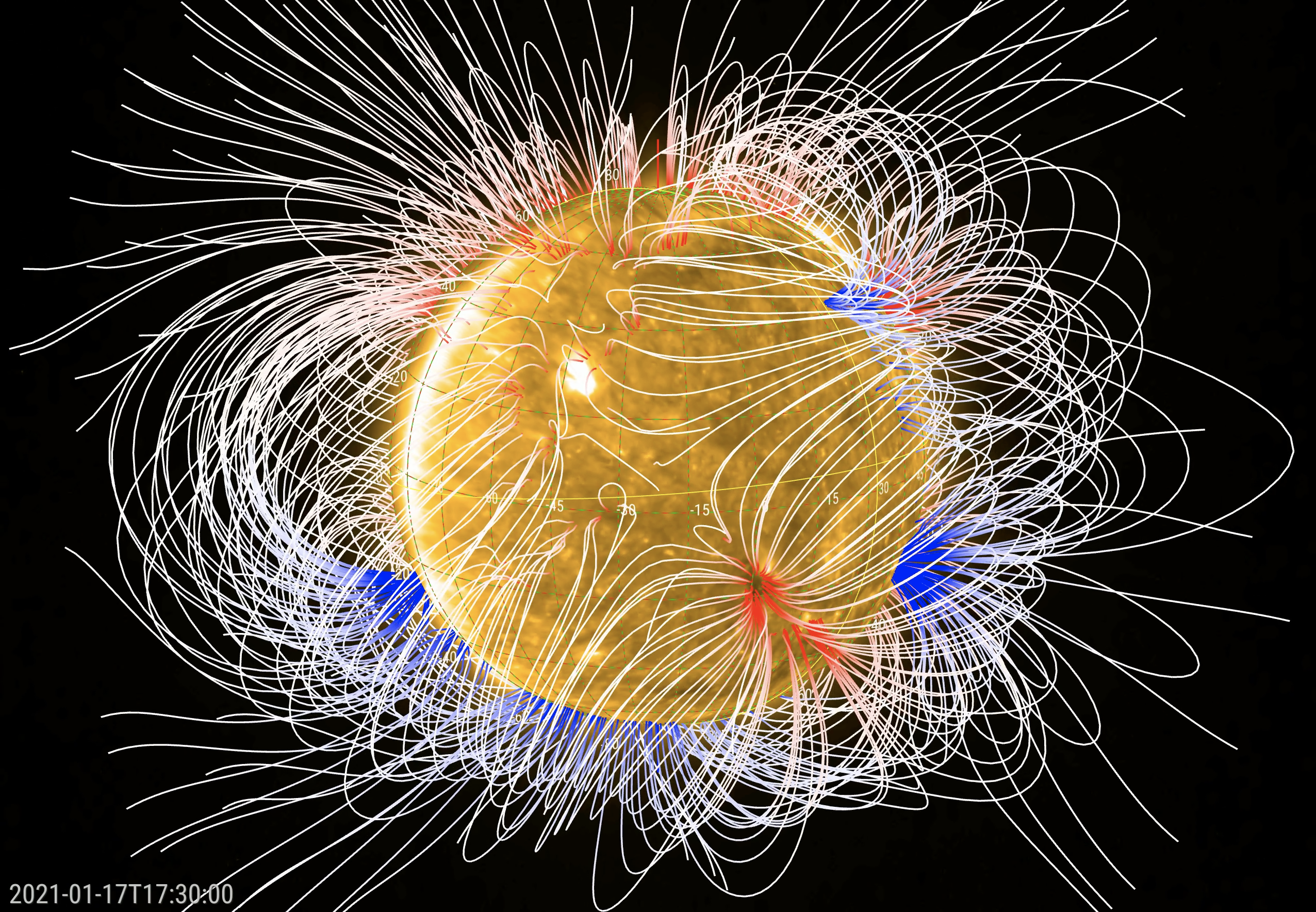
The 'wild movie' made with JHelioviewer: https://www.stce.be/movies/JHV_2021-02-04_11.23.28%20copy.mp4
This one is also nice with a jumping Sun: https://www.stce.be/movies/20210201-17_beacon_fsi_30fpsI.mp4
Frédéric, Emil and David were of course not alone. They are part of a team in which all sorts of talents and expertise is gathered. Everybody: 'It has been a busy year. But it was worth it, also because EUI discovered tiny campfires. The campfire images are the result of a complex chain of engineering, IT and scientific processes and we all are part of this!'
Delivery service of SWx experts
Space Weather is 'in' and more and more organisations want to learn about it. They are right to do so.
Solar storms drop their energy in the Earth's magnetosphere and atmosphere and as such lie at the basis of space weather. Technology that relies on satellite navigation and radio wave propagation can be impacted by space weather, as well as large energy transport systems like electrical grids. Harmful radiation at flight altitude can increase when a solar storm hits Earth.
We just finished a crash course 'Introduction to Space Weather'. Six USAF participants were submerged into the world of sporadic and massive eruptions of highly energetic matter and radiation from the Sun and into magnetospheric and ionospheric processes to finally dig deeper into space weather parameters relevant for aviation.
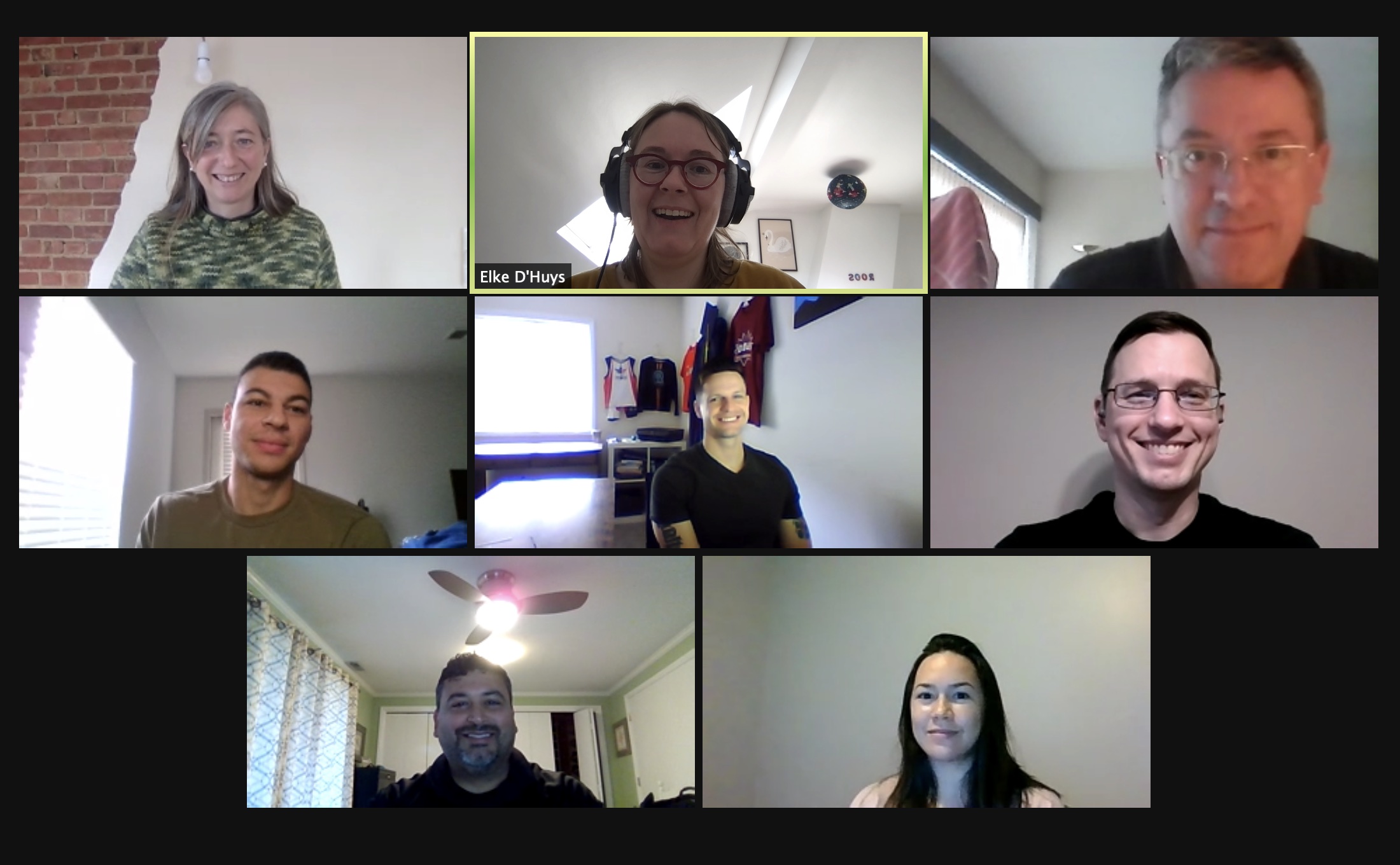
All participants passed the test with excellent scores and got their certificate. Congratulations Kalie, Anthony, Donald, Jacob, Miguel and Raymond!
Review of solar activity
The solar activity was at very low level. The week started with a spotless solar disk. On Feb 8th a new faint bi-polar active region emerged close to the south-east limb. It was detected by Catania as sunspot group 71 on Feb 9th and decayed into a plage on Feb 10th. The flaring activity remained below C-class flare level.
No Earth-directed Coronal Mass Ejections (CMEs) were observed in the available chronograph imagery for the entire week.
The greater than 10 MeV proton flux remained at background levels over the entire week.
The greater than 2 MeV electron flux was under the 1000 pfu threshold and the electron fluence was at nominal levels.
The International Sunspot Number by Silso
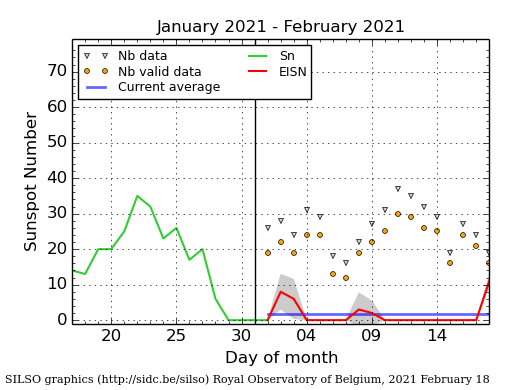
The daily Estimated International Sunspot Number (EISN, red curve with shaded error) derived by a simplified method from real-time data from the worldwide SILSO network. It extends the official Sunspot Number from the full processing of the preceding month (green line), a few days more than one solar rotation. The horizontal blue line shows the current monthly average. The yellow dots gives the number of stations that provided valid data. Valid data are used to calculate the EISN. The triangle gives the number of stations providing data. When a triangle and a yellow dot coincide, it means that all the data is used to calculate the EISN of that day.
PROBA2 Observations (8 Feb 2021 - 14 Feb 2021)
Solar Activity
Solar flare activity was very low during the week.
In order to view the activity of this week in more detail, we suggest to go to the following website from which all the daily (normal and difference) movies can be accessed: https://proba2.oma.be/ssa
This page also lists the recorded flaring events.
A weekly overview movie can be found here (SWAP week 568): https://proba2.sidc.be/swap/data/mpg/movies/weekly_movies/weekly_movie_2021_02_08.mp4
Details about some of this week's events can be found further below.
If any of the linked movies are unavailable they can be found in the P2SC movie repository here: https://proba2.oma.be/swap/data/mpg/movies/
Wednesday Feb 10
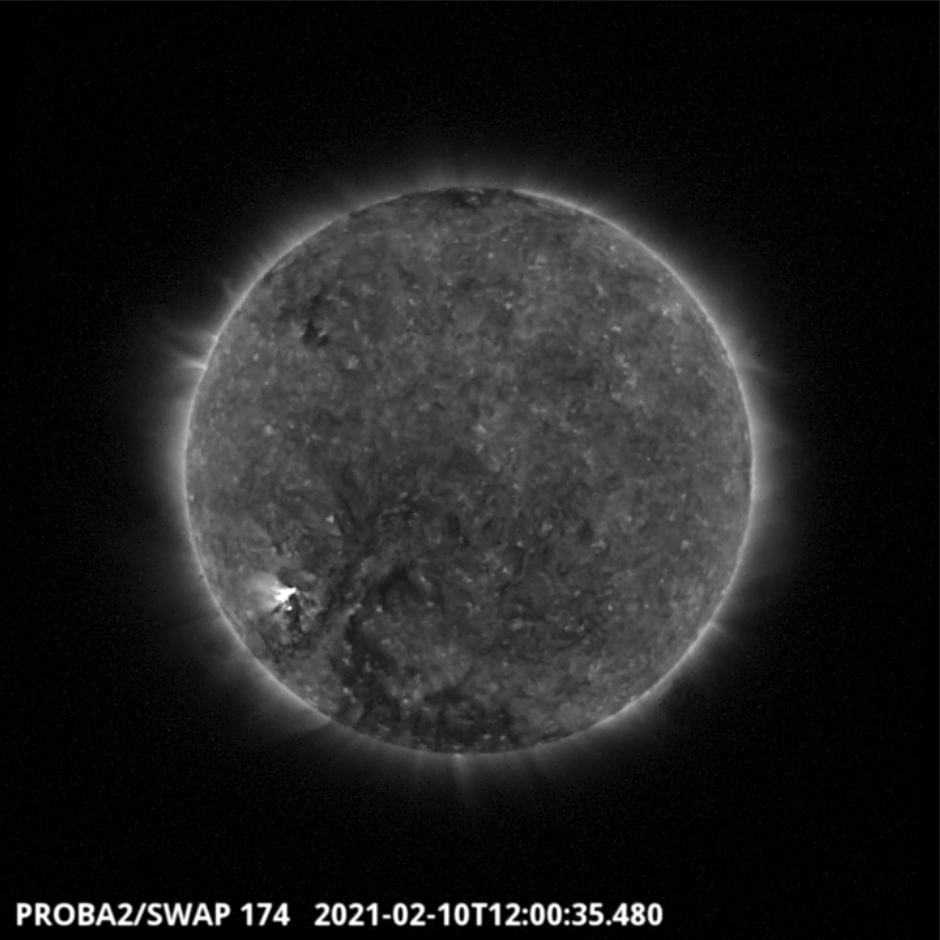
The largest flare of the week was a B6 flare, which was observed by SWAP and LYRA on 2021-Feb-10. The flare occurred in the south-eastern quadrant of the solar disk, as shown in the SWAP image above taken at 12:00 UT.
Find a movie of the event here: https://proba2.sidc.be/swap/movies/20210210_swap_movie.mp4 (SWAP movie)
Review of geomagnetic activity
A high speed stream (HSS) emanating from a positive polarity coronal hole, reached the Earth on Feb 6th. The DSCOVR and ACE satellites in the L1 point measured speeds exceeding 500 km/s on Feb 7th, Feb 8th and Feb 9th.
The solar wind began to settle down on Feb 10th and remained at nominal levels on Feb 11th and Feb 12th.
In the evening of Feb 12th another HSS related to a high-latitude extension of the southern polar coronal hole reached the Earth. The total interplanetary magnetic field strength reached 15 nT around 02:30 UTC on Feb 13th. The north-south Bz component reached -14 nT. The solar wind velocity exceeded 500 km/s with a maximum of 551 km/s. The geomagnetic effect of this HSS began to subside from Feb 14th.
The geomagnetic conditions over the week were mostly quiet.
The first HSS lead to a single 3-hour period of unsettled geomagnetic condition on Feb 8th.
The second HSS lead to several unsettled periods on Feb 12th.
Unsettled to quiet geomagnetic conditions prevailed on Feb 13th with an isolated active period.
The SIDC Space Weather Briefing
The Space Weather Briefing presented by the forecaster on duty from Feb 7 to 14. It reflects in images and graphs what is written in the Solar and Geomagnetic Activity report.

A pdf-version: https://www.stce.be/briefings/20210215_SWbriefing.pdf
The movie: https://www.stce.be/briefings/20210215_SWbriefing.m4v
Review of ionospheric activity (8 Feb 2021 - 14 Feb 2021)
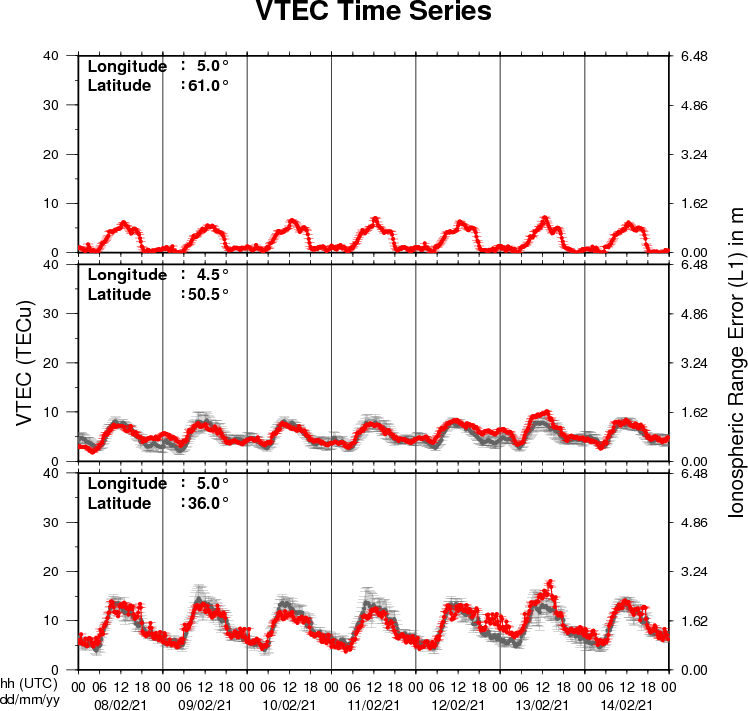
The figure shows the time evolution of the Vertical Total Electron Content (VTEC) (in red) during the last week at three locations:
a) in the northern part of Europe(N61°, 5°E)
b) above Brussels(N50.5°, 4.5°E)
c) in the southern part of Europe(N36°, 5°E)
This figure also shows (in grey) the normal ionospheric behaviour expected based on the median VTEC from the 15 previous days.
The VTEC is expressed in TECu (with TECu=10^16 electrons per square meter) and is directly related to the signal propagation delay due to the ionosphere (in figure: delay on GPS L1 frequency).
The Sun's radiation ionizes the Earth's upper atmosphere, the ionosphere, located from about 60km to 1000km above the Earth's surface.The ionization process in the ionosphere produces ions and free electrons. These electrons perturb the propagation of the GNSS (Global Navigation Satellite System) signals by inducing a so-called ionospheric delay.
See http://stce.be/newsletter/GNSS_final.pdf for some more explanations ; for detailed information, see http://gnss.be/ionosphere_tutorial.php
